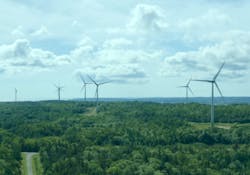Green Hydrogen firm investing $758M to buy three Nova Scotia Wind Farms
EverWind Fuels, A Canadian green hydrogen venture, has purchased three 530 MW wind farm development projects designed to eventually provide clean power for hydrogen production in Nova Scotia.
The $1 billion deal (in Canadian dollars, $758M U.S.) will acquire the Windy Ridge, Bear Lake and Kmtnuk wind farm projects, the latter two in partnership with native community business Membertou.
“The power generated at these three new developments will also ensure EverWind's green hydrogen and ammonia will meet the strictest international standards for green fuels,” said Trent Vichie, CEO of EverWind.
The wind farms, to be developed and constructed in partnership with Renewable Energy Systems (RES), will create approximately 650 construction and 30 full-time positions in Nova Scotia. They will not only support 80 percent renewable energy sales by 2030 but will also take care of grid and renewable energy transition in the province.
“The wind projects are well advanced through the Nova Scotia Power interconnection process and are currently undergoing environmental assessment field investigations to allow for the commencement of a full EA process in Fall of 2023,” said Peter Clibbon, Senior VP of Development for RES in Canada.
The green hydrogen and ammonia plant will be developed and constructed by Black & Veatch. Green hydrogen is produced when electrolyzers, which split the H2 from water, are powered by carbon-free energy resources such as solar, wind, hydro or nuclear.
"We are in the final stages of front-end engineering and design (FEED) for the Phase 1 production facility and are progressing all workstreams to deliver on-time and on-budget,” said Ali Assaf, Black & Veatch Vice President and Managing Director.
All power for EverWind's Phase 1 of production will be supplied to its Point Tupper facility. EverWind plans to purchase and lease land near the facility to use up to 300 MW of solar power to support production and further enhance grid flexibility benefits.
The first phase of EverWind's production will utilize PEM electrolyzers and with the wind farm development, EverWind expects to generate 2.5 TWh, providing the power for over 200,000 tons of ammonia.
While EverWind has signed an MOU to lease Crown land for an additional 2 GW of wind for Phase 2 of its production, it is also in the process of developing a green hydrogen project in Newfoundland and Labrador. EverWind will be appointing a verification firm to certify that its green hydrogen production meets the international standards, along with the European RFNBO.
About the Author
Rod Walton, EnergyTech Managing Editor
Managing Editor
For EnergyTech editorial inquiries, please contact Managing Editor Rod Walton at [email protected].
Rod Walton has spent 17 years covering the energy industry as a newspaper and trade journalist. He formerly was energy writer and business editor at the Tulsa World. Later, he spent six years covering the electricity power sector for Pennwell and Clarion Events. He joined Endeavor and EnergyTech in November 2021.
Walton earned his Bachelors degree in journalism from the University of Oklahoma. His career stops include the Moore American, Bartlesville Examiner-Enterprise, Wagoner Tribune and Tulsa World.
EnergyTech is focused on the mission critical and large-scale energy users and their sustainability and resiliency goals. These include the commercial and industrial sectors, as well as the military, universities, data centers and microgrids. The C&I sectors together account for close to 30 percent of greenhouse gas emissions in the U.S.
He was named Managing Editor for Microgrid Knowledge and EnergyTech starting July 1, 2023
Many large-scale energy users such as Fortune 500 companies, and mission-critical users such as military bases, universities, healthcare facilities, public safety and data centers, shifting their energy priorities to reach net-zero carbon goals within the coming decades. These include plans for renewable energy power purchase agreements, but also on-site resiliency projects such as microgrids, combined heat and power, rooftop solar, energy storage, digitalization and building efficiency upgrades.

